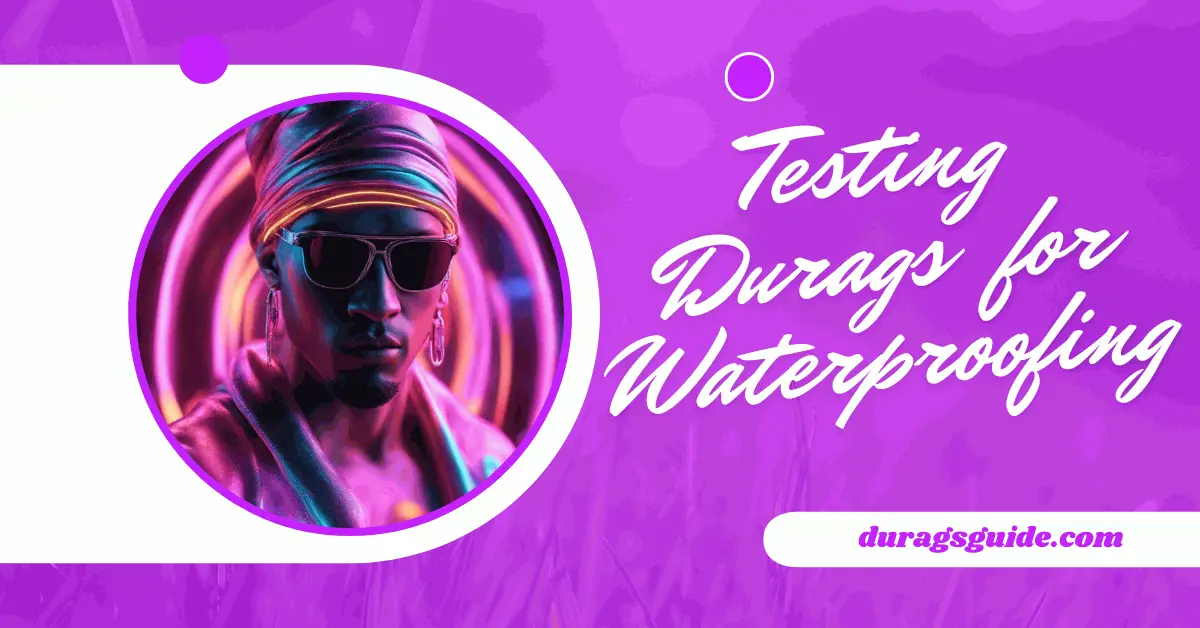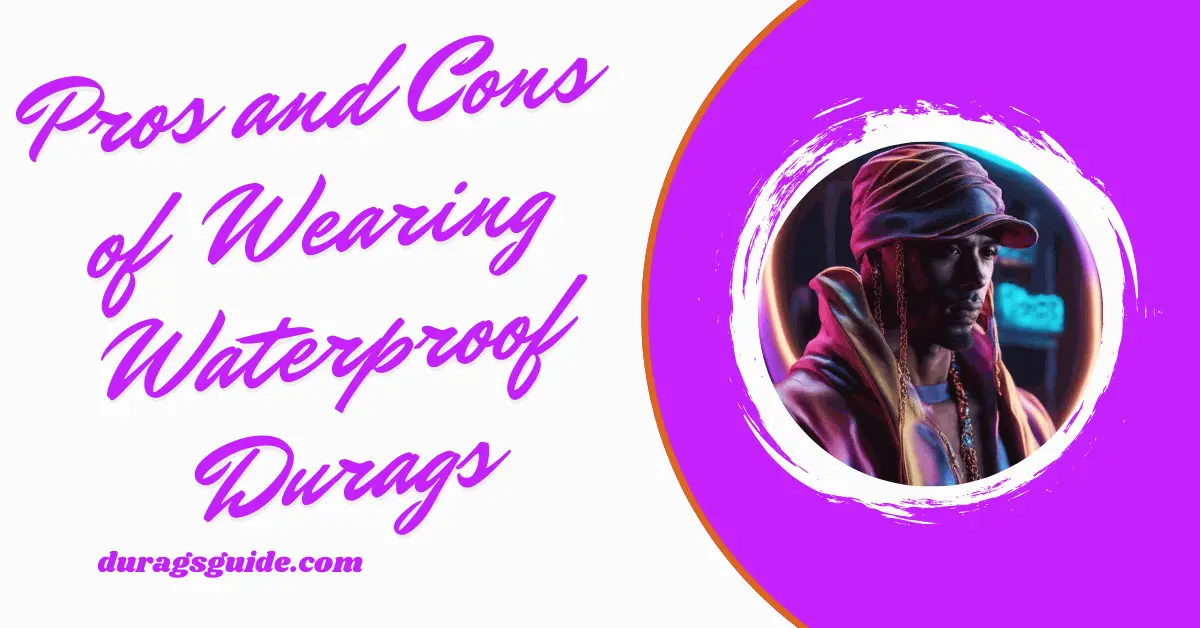Introduction to Durags
Durags have a rich history and cultural significance, and they have gained popularity in modern fashion and grooming. They are a type of headwear commonly worn by individuals of various backgrounds and ethnicities. Durags are typically made from a variety of materials, such as silk, satin, or nylon, and they are designed to be worn tightly over the head, covering the hair. There are many different durags for modern stylish look. In this article we will know about the fact that Are Durags Waterproof? or not.
Materials Used in Durags
Durags are made from a variety of materials, each with its own properties and characteristics. The choice of material plays a significant role in determining the durability, comfort, and functionality of the durag. When considering the waterproofness of durags, it is important to understand how different materials can affect their performance.
Common Fabrics and Their Properties
- Silk: Silk is a natural fabric known for its smooth and luxurious feel. It is lightweight, breathable, and gentle on the hair and skin. Silk durags are popular for their comfort and ability to help maintain moisture in the hair. However, silk itself is not inherently waterproof and may require additional treatments or coatings to enhance its water resistance.
- Satin: Satin is a synthetic fabric that mimics the appearance and feel of silk. It is often made from polyester or nylon fibers. Satin durags are known for their softness and durability. While satin is not completely waterproof, it has some water-resistant properties that can help protect the hair from light moisture.
- Nylon: Nylon is a synthetic fabric that is lightweight, durable, and quick-drying. It is often used in athletic or performance durags due to its moisture-wicking properties. Nylon durags can offer some level of water resistance, making them suitable for activities where the head may come into contact with water or sweat.
- Polyester: Polyester is another synthetic fabric commonly used in durags. It is known for its strength, wrinkle resistance, and ability to retain color. Polyester durags can provide some resistance to water, but they may not be completely waterproof without additional treatments or coatings.

What Does Waterproof Mean?
Before diving into the topic of whether durags are waterproof, it’s important to understand what waterproof actually means, as well as the related terms water-resistant and water-repellent. These terms are often used interchangeably, but they have distinct meanings in the context of fabric and materials.
Definition and Importance of Waterproofing Waterproof refers to the ability of a material or product to resist the penetration of water. When something is deemed waterproof, it means that it can effectively keep water out, preventing it from passing through the material and reaching the underlying layers. Waterproofing is crucial in various applications, such as outdoor gear, rainwear, and protective clothing, where keeping the body dry is essential.
Differences between Waterproof, Water-Resistant, and Water-Repellent
- Waterproof: A waterproof material is designed to prevent the passage of water entirely. It forms a barrier that resists water penetration, keeping the underlying layers dry even in wet conditions.
- Water-Resistant: A water-resistant material has the ability to resist the penetration of water to a certain extent. While it may not completely prevent water from entering, it can withstand light rain or moisture without becoming saturated.
- Water-Repellent: A water-repellent material is treated or coated with substances that cause water to bead up and roll off the surface, rather than being absorbed. While water-repellent materials can repel light rain or splashes, they are not designed to withstand prolonged exposure to heavy rain or complete immersion.
Understanding these distinctions is important when examining the waterproofness of durags. While a durag may not necessarily be completely waterproof, it may still offer some level of water resistance or water repellency. In the next sections, we will explore whether durags are typically waterproof and how different durag materials perform in terms of water resistance.

Are Durags Waterproof? The Basics
When considering whether durags are waterproof, it’s important to understand that not all durags are created equal in terms of water resistance. The waterproofness of a durag can vary depending on factors such as the material used, fabric construction, and any additional treatments applied. Let’s explore the basics of durags and their water resistance.
Are Durags Typically Waterproof? Durags are primarily designed to protect and maintain hairstyles rather than to be completely waterproof. Traditional durags made from materials like silk or satin are not inherently waterproof. These fabrics can provide some level of moisture resistance, but they are not designed to keep the hair completely dry in wet conditions.
Durags made from synthetic materials like nylon or polyester may offer better water resistance due to their composition and construction. These materials are often used in athletic or performance durags that are designed to wick away moisture and provide some protection against light rain or sweat.
Examination of Common Durag Materials and Water Resistance
- Silk Durags: Silk durags are known for their comfort and ability to help maintain moisture in the hair. While silk has natural moisture-wicking properties, it is not completely waterproof. Silk durags may repel light moisture to some extent, but they are not designed to keep the hair dry in heavy rain or water exposure.
- Satin Durags: Satin durags, typically made from polyester or nylon, offer better water resistance compared to silk. Satin has some water-repellent properties that can provide protection against light rain or moisture. However, satin durags may not be completely waterproof and may become saturated if exposed to heavy rain or prolonged water contact.
- Nylon and Polyester Durags: Durags made from synthetic materials like nylon or polyester often offer better water resistance. These fabrics have inherent moisture-wicking properties and can repel light moisture. Nylon and polyester durags are commonly used in athletic or performance settings, where some level of water resistance is desired.
It’s important to note that even durags made from more water-resistant materials may not be fully waterproof. They may offer some protection against light moisture or splashes, but they may not withstand heavy rain or complete immersion in water.

Testing Durags for Waterproofing
To assess the waterproofness of durags, various testing methods can be employed to determine their ability to resist water penetration. These tests help provide insights into the level of water resistance offered by different durag materials. Let’s explore some common testing methods and examine the results obtained from testing various durag materials.
Methods to Test Waterproofness
- Spray Test: In a spray test, a durag is subjected to a controlled spray of water from different angles and intensities. This test simulates exposure to rain or splashes to determine how well the durag repels water and keeps the underlying layers dry.
- Submersion Test: The submersion test involves immersing a durag in water for a specific period. This test assesses the durag’s ability to withstand complete water immersion without becoming saturated or allowing water to penetrate through the fabric.
- Fabric Absorption Test: This test measures how much water a durag fabric absorbs. It involves placing a predetermined amount of water on the fabric’s surface and monitoring the rate and extent of absorption. Fabrics with low absorption rates are more likely to exhibit water repellency.
Results from Testing Durag Materials Results from testing durag materials for waterproofing can vary depending on the specific fabric and its composition. Here are some general observations:
- Silk Durags: Silk durags are not typically designed to be fully waterproof. Testing may reveal that silk durags have limited water resistance, with water being absorbed to some extent. While silk can repel light moisture, it may not provide complete protection against heavy rain or water immersion.
- Satin Durags: Satin durags, especially those made from synthetic materials like polyester or nylon, are often more water-resistant than silk. Testing may show that satin durags have better water repellency, with water beading up on the surface and a slower rate of absorption compared to silk.
- Nylon and Polyester Durags: Durags made from synthetic materials like nylon or polyester tend to exhibit better water resistance. Testing may reveal that these durags repel water effectively, with minimal absorption and better overall water repellency.
It’s important to note that individual durags may perform differently in testing, depending on factors such as fabric quality, construction, and any additional treatments applied. While some durags may demonstrate higher water resistance, it’s unlikely that they would be completely waterproof.

Pros and Cons of Wearing Waterproof Durags
Wearing a waterproof durag can have its advantages and disadvantages, depending on your specific needs and preferences. Let’s explore the pros and cons of wearing waterproof durags to help you make an informed decision.
Pros of Wearing Waterproof Durags
- Protection from Rain and Moisture: Waterproof durags can provide enhanced protection against rain and moisture. They can help keep your hair dry and prevent it from becoming frizzy or damaged in wet conditions.
- Durability and Longevity: Waterproof durags are often made from materials that are more durable and resistant to wear and tear. They can withstand exposure to water and moisture without compromising their quality, making them a long-lasting option.
- Versatility: Waterproof durags can be worn in various settings and activities where water exposure is a concern. Whether you’re engaging in outdoor sports, swimming, or simply walking in the rain, a waterproof durag can help keep your hair protected.
Cons of Wearing Waterproof Durags
- Breathability: Waterproof materials may not be as breathable as natural fabrics like silk or satin. This can lead to potential discomfort and heat buildup, especially in warmer climates or during intense physical activity.
- Limited Style and Material Options: Waterproof durags may have a more limited range of styles and materials compared to traditional durags. While synthetic materials like nylon and polyester are commonly used for waterproof durags, they may not have the same aesthetic appeal as silk or satin for certain individuals.
- Waterproof ≠ Sweatproof: It’s important to note that waterproof durags are not necessarily sweatproof. While they may provide water resistance, they may not effectively wick away sweat or moisture from the scalp. This can lead to discomfort and potential issues like odor or scalp irritation.

Enhancing Water Resistance in Durags
If you’re interested in increasing the water resistance of your durag, there are several steps you can take to enhance its performance. While these methods may not make the durag completely waterproof, they can provide an extra layer of protection against moisture. Let’s explore some ways to enhance the water resistance of durags.
- Water-Repellent Sprays: Applying a water-repellent spray to your durag can help improve its ability to repel water. These sprays create a protective barrier on the fabric, causing water to bead up and roll off instead of being absorbed. Make sure to follow the instructions provided with the spray and test it on a small, inconspicuous area of the durag first to ensure compatibility.
- Waterproofing Treatments: Some durag manufacturers offer waterproofing treatments specifically designed for their products. These treatments can enhance the fabric’s water resistance and provide a longer-lasting effect compared to sprays. Look for durags that are pre-treated with a waterproofing solution or consider applying a waterproofing treatment yourself, following the manufacturer’s instructions.
- Laminating or Coating: Another method to enhance water resistance is to laminate or coat the durag with a waterproof membrane or film. This additional layer acts as a barrier against water, preventing it from penetrating the fabric. However, keep in mind that this may alter the appearance and texture of the durag.
- Choosing Water-Resistant Materials: When purchasing a durag, consider opting for materials known for their water-resistant properties. Fabrics like nylon or polyester are often more water-resistant than silk or satin. Look for durags made from these synthetic materials if water resistance is a priority for you.
- Proper Care and Maintenance: Regularly cleaning and maintaining your durag can help preserve its water-resistant qualities. Follow the care instructions provided by the manufacturer to ensure that the durag retains its water repellency over time. Avoid using harsh detergents or fabric softeners that can strip away the protective coatings or treatments.

Final Thoughts
In conclusion, durags are not typically designed to be fully waterproof. While some durags may offer varying levels of water resistance or water repellency, they are primarily intended to protect and maintain hairstyles rather than keep the hair completely dry in wet conditions. Factors such as the material used, fabric construction, and any additional treatments applied can affect the water resistance of a durag. While certain durags made from synthetic materials may offer better water resistance, it’s important to manage expectations and understand that durags are not inherently waterproof.
FAQS
Are there waterproof durags available?
Yes, some manufacturers offer durags with waterproof coatings or materials designed to provide better protection against water.
How can I protect my hair while wearing a durag in wet conditions?
To protect your hair while wearing a durag in wet conditions, consider using a shower cap or covering the durag with a waterproof hat or hood.
Can I wear a durag while participating in water sports?
While durags can help secure your hair during water sports, they may not provide complete waterproofing and may get wet.
Will a durag protect my hair from chlorine in pools?
Durags can provide a layer of protection against chlorine, but they may not fully prevent your hair from getting wet or absorbing chemicals.
Are there durags specifically made for swimming?
Yes, some brands offer durags specifically designed for swimming, with waterproof materials and features to enhance water resistance.
How can I maintain my durag’s water resistance?
To maintain water resistance, avoid excessive stretching, washing with harsh detergents, and ensure proper drying after use to prevent mold or mildew growth.
